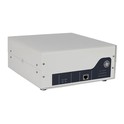Hey there! As a supplier of the ResoLab - 1000 Lab Grade Ultrasonicator, I've seen firsthand how awesome this piece of equipment is. But like any other high - tech gadget, it needs proper maintenance to keep it running smoothly. In this blog, I'm gonna share some tips on how to maintain your ResoLab - 1000, so you can get the most out of it for years to come.
Understanding the ResoLab - 1000
Before we dive into maintenance, let's quickly go over what the ResoLab - 1000 Lab Grade Ultrasonicator is all about. This ultrasonicator is a powerful tool used in laboratories for a variety of applications, such as cell disruption, sample preparation, and dispersion. It works by generating high - frequency sound waves that create cavitation bubbles in the liquid, which then collapse and produce intense energy to break down particles or mix substances.
Regular Cleaning
One of the most important aspects of maintaining the ResoLab - 1000 is regular cleaning. After each use, make sure to clean the probe and the sample container thoroughly. The probe can accumulate debris and residue from the samples, which can affect its performance over time. Use a mild detergent and warm water to clean the probe, and then rinse it thoroughly with distilled water. Dry the probe completely before storing it to prevent corrosion.
The sample container also needs to be cleaned to prevent cross - contamination between different samples. Empty the container after each use and rinse it with water. You can use a brush to scrub away any stubborn residue. For a more thorough cleaning, you can soak the container in a cleaning solution for a few hours. Just make sure to follow the manufacturer's instructions when using cleaning solutions.
Probe Inspection
The probe is the heart of the ResoLab - 1000, so it's crucial to inspect it regularly. Check for any signs of wear and tear, such as cracks, chips, or erosion. If you notice any damage to the probe, stop using it immediately and contact our support team. A damaged probe can not only affect the performance of the ultrasonicator but also pose a safety risk.
In addition to visual inspection, you should also check the probe's tip for proper alignment. A misaligned tip can cause uneven cavitation and reduce the efficiency of the ultrasonicator. If you're not sure how to check the alignment, refer to the user manual or give us a call, and we'll guide you through the process.
Power Supply and Electrical Components
The power supply and electrical components of the ResoLab - 1000 need to be maintained properly to ensure safe and reliable operation. Make sure the power cord is in good condition, without any fraying or exposed wires. If you notice any damage to the power cord, replace it immediately.


Check the electrical connections regularly to make sure they are tight and secure. Loose connections can cause electrical problems and even damage the ultrasonicator. If you're not comfortable working with electrical components, it's best to have a professional technician perform the inspection.
Cooling System
The ResoLab - 1000 generates heat during operation, so it has a cooling system to prevent overheating. The cooling system usually consists of a fan and a heat sink. Make sure the fan is working properly and that there is no dust or debris blocking the air vents. You can use a can of compressed air to blow out any dust from the fan and the air vents.
Regularly check the heat sink for any signs of damage or blockage. A blocked heat sink can cause the ultrasonicator to overheat, which can lead to premature failure of the components. If you notice any problems with the cooling system, contact us right away.
Software and Firmware Updates
Just like your smartphone or computer, the ResoLab - 1000 may require software and firmware updates from time to time. These updates can improve the performance of the ultrasonicator, add new features, and fix any bugs or security vulnerabilities.
Keep an eye on our website or subscribe to our newsletter to stay informed about the latest updates. When an update is available, follow the instructions in the user manual to install it. It's usually a straightforward process, but if you have any questions, don't hesitate to reach out to us.
Comparison with Other ResoLab Ultrasonicators
If you're considering other options in the ResoLab line, we also offer the ResoLab - 500 Lab Grade Ultrasonicator and the ResoLab - 2000 Lab Grade Ultrasonicator. The ResoLab - 500 is a more compact and affordable option, suitable for smaller laboratories or less demanding applications. On the other hand, the ResoLab - 2000 is a more powerful model, capable of handling larger volumes and more challenging tasks.
The maintenance procedures for these models are similar to those of the ResoLab - 1000, but there may be some minor differences. Make sure to refer to the specific user manual for each model for detailed maintenance instructions.
Conclusion
Maintaining your ResoLab - 1000 Lab Grade Ultrasonicator is essential to ensure its long - term performance and reliability. By following these simple maintenance tips, you can keep your ultrasonicator in top shape and avoid costly repairs or replacements.
If you have any questions about maintaining your ResoLab - 1000 or if you're interested in purchasing one, feel free to reach out to us. We're here to help you get the most out of your laboratory equipment. Whether you're a small research lab or a large - scale industrial facility, we have the right solution for you.
References
- ResoLab - 1000 Lab Grade Ultrasonicator User Manual
- Industry standards for laboratory ultrasonicator maintenance





